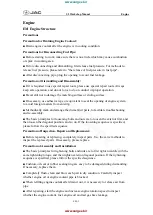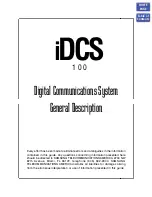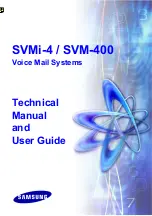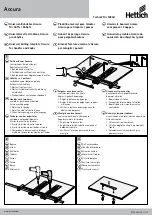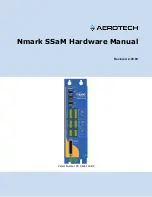
Engine Maintenance (Rev. 04/02)
35
Checking the Antifreeze
Check the solution concentration by using a temperature
compensated antifreeze hydrometer or a refractometer
(P/N 204-754) designed for testing antifreeze. Maintain a
minimum of 50% permanent type antifreeze concentrate
and 50% water solution to provide protection to -30 F
(-34 C). Do not mix antifreeze stronger than 68% perma-
nent type coolant concentrate and 32% water for use in
extreme temperatures.
Changing the Antifreeze
1.
Run the engine until it is up to its normal operating
temperature. Stop the unit.
2.
Open the engine block drain (located behind the starter)
and completely drain the coolant. Observe the coolant
color. If the coolant is dirty, proceed with a, b and c.
Otherwise go to 3.
CAUTION: Avoid direct contact with hot
coolant.
a.
Run clear water into the radiator and allow it to
drain out of the block until it is clear.
b.
Close the block drain and install a commercially
available radiator and block flushing agent, and
operate the unit in accordance with instructions of
the flushing agent manufacturer.
c.
Open the engine block drain to drain the water and
flushing solution.
CAUTION: Avoid direct contact with hot
coolant.
3.
Run clear water into the radiator, and allow it to drain
out of the block until it is clear.
4.
Inspect all hoses for deterioration and hose clamp tight-
ness. Replace if necessary.
5.
Loosen the water pump belt. Check the water pump
bearing for looseness.
6.
Inspect the radiator cap. Replace the cap if the gasket
shows any signs of deterioration.
7.
Determine which type of antifreeze to use. Conven-
tional coolants are green or blue-green. ELC is red. Do
not mix conventional coolants and ELC. See “ELC
(Extended Life Coolant)” on page 32 to help determine
which type of antifreeze to use.
8.
Mix one gallon of the appropriate permanent antifreeze
concentrate and one gallon clean water in a container to
make a 50/50 mixture. (Do not add antifreeze and then
add water to the unit. This procedure may not give a
true 50/50 mixture because the exact cooling system
capacity may not always be known.)
9.
Refill the radiator with the 50/50 antifreeze mixture and
make sure to bleed the air from the cooling system as
needed.
Bleeding Air from the Cooling System
Jiggle pin thermostats are original equipment on units that
have TK 486 engines. Jiggle pin thermostats make it unnec-
essary to bleed the air out of the engine block because they
keep air from being trapped in the engine block. Normally,
when the cooling system is drained, approximately 6 quarts
(5.7 liters) of coolant drain out. If approximately 3 quarts
(2.8 liters) of coolant seem to fill the cooling system after it
has been drained, air has been trapped in the block. Bleed
the air out of the block using the following procedure:
CAUTION: IF YOU SUSPECT THAT AIR IS
TRAPPED IN THE BLOCK, DO NOT START
THE ENGINE WITHOUT BLEEDING THE AIR
OUT OF THE BLOCK. REFER TO SERVICE
BULLETIN T&T 029.
Summary of Contents for SB-III 30 SR+
Page 4: ......
Page 8: ......
Page 10: ...ii ...
Page 14: ...4 ...
Page 24: ...Unit Description Rev 04 02 14 Unit Photos Front View AGA231 ...
Page 28: ...18 ...
Page 66: ...56 ...
Page 98: ...88 ...
Page 110: ...100 ...
Page 111: ...101 Early Model Coiled Wire Fuse Link Wiring Schematic ...
Page 112: ...102 Early Model Coiled Wire Fuse Link Wiring Diagram Page 1 of 4 ...
Page 113: ...103 Early Model Coiled Wire Fuse Link Wiring Diagram Page 2 of 4 ...
Page 114: ...104 Early Model Coiled Wire Fuse Link Wiring Diagram Page 3 of 4 ...
Page 115: ...105 Early Model Coiled Wire Fuse Link Wiring Diagram Page 4 of 4 ...
Page 116: ...106 Late Model Fuse Link in Battery Cable Wiring Schematic ...
Page 117: ...107 Late Model Fuse Link in Battery Cable Wiring Diagram Page 1 of 4 ...
Page 118: ...108 Late Model Fuse Link in Battery Cable Wiring Diagram Page 2 of 4 ...
Page 119: ...109 Late Model Fuse Link in Battery Cable Wiring Diagram Page 3 of 4 ...
Page 120: ...110 Late Model Fuse Link in Battery Cable Wiring Diagram Page 4 of 4 ...































